My algorithm outputs the set of vertices describing objects in 3D space (x, y, z). In this case, there are two objects:
verts =
[[0.1 1. 1. ] [1. 1. 0.1] [1. 0.1 1. ] [1. 1. 1.9] [1. 1.9 1. ]
[1.9 1. 1. ] [7.1 8. 8. ] [8. 8. 7.1] [8. 7.1 8. ] [8. 8. 8.9]
[8. 8.9 8. ] [8.9 8. 8. ]]
There are two tetrahedrons, one confined between centered on (1, 1, 1), the other on (8, 8, 8). My goal is to use breadth-first search to identify that the objects are separate, and then classify each. I have not been able to get the data in the correct form for my algorithm.
Instead, I intend to use the networkx module, specifically using the Graph class, which takes ndarrays as input. I have tried:
import networkx as nx
import numpy as np
graph = Graph(verts)
for idx, graph in enumerate(nx.connected_components(graph)):
print("Graph ",idx, " in ", graph,'\n\n',file=open("output.txt","a"))
However, I cannot create graph. Instead, I get the error:
"Input is not a correct numpy matrix or array.")
networkx.exception.NetworkXError: Input is not a correct numpy matrix or array.
This confuses me because type of verts = numpy.ndarray.
I am open to either using networkx for this task, or developing some other strategy. Additionally, please let me know if there are any edits that might make this post more clear.

Edit: One thing that may help is another output, faces. These 'define triangular faces via referencing vertex indices from verts.' I believe these can be used to 'connect' or draw lines from vertex to vertex, eventually to create a dictionary.
faces =
[[ 2 1 0] [ 0 3 2] [ 1 4 0] [ 0 4 3] [ 5 1 2] [ 3 5 2]
[ 5 4 1] [ 4 5 3] [ 8 7 6] [ 6 9 8] [ 7 10 6] [ 6 10 9]
[11 7 8] [ 9 11 8] [11 10 7] [10 11 9]]
A method has been proposed, and it works for this set of data. However, it does not work for all. This edit uploads a new set of data.
verts =
[[0.1 1. 1. ] [1. 1. 0.1] [1. 0.1 1. ] [1. 1. 1.9] [1. 1.9 1. ] [1.9 1. 1. ]
[3.1 1. 4. ] [4. 1. 3.1] [4. 0.1 4. ] [4. 1. 4.9] [4. 1.9 4. ] [5. 1. 3.1]
[5. 0.1 4. ] [5. 1. 4.9] [5. 1.9 4. ] [5.9 1. 4. ] [7.1 8. 8. ]
[8. 8. 7.1] [8. 7.1 8. ] [8. 8. 8.9] [8. 8.9 8. ] [9. 8. 7.1]
[9. 7.1 8. ] [9. 8. 8.9] [9. 8.9 8. ] [9.9 8. 8. ]]
And it looks like this.
